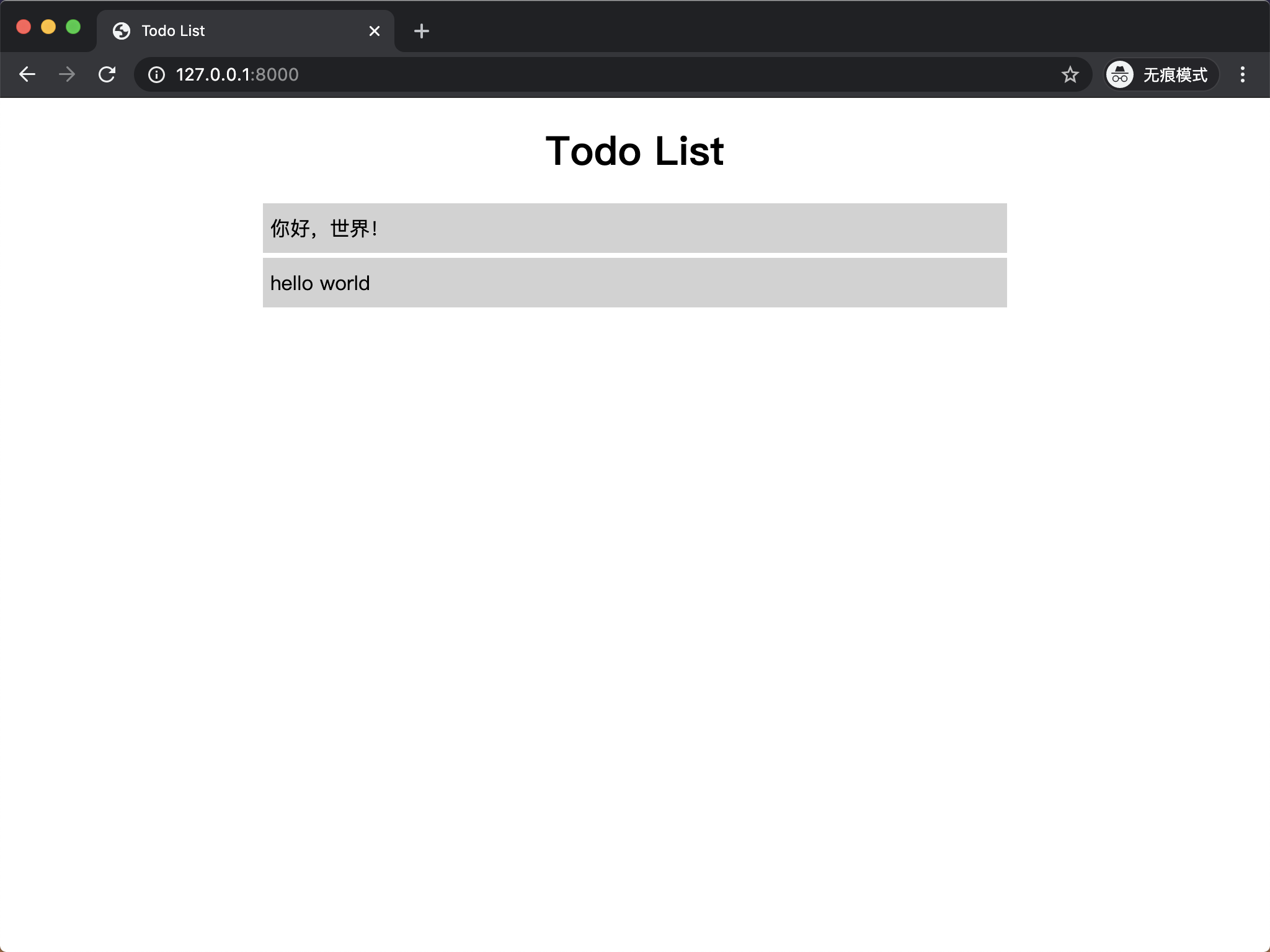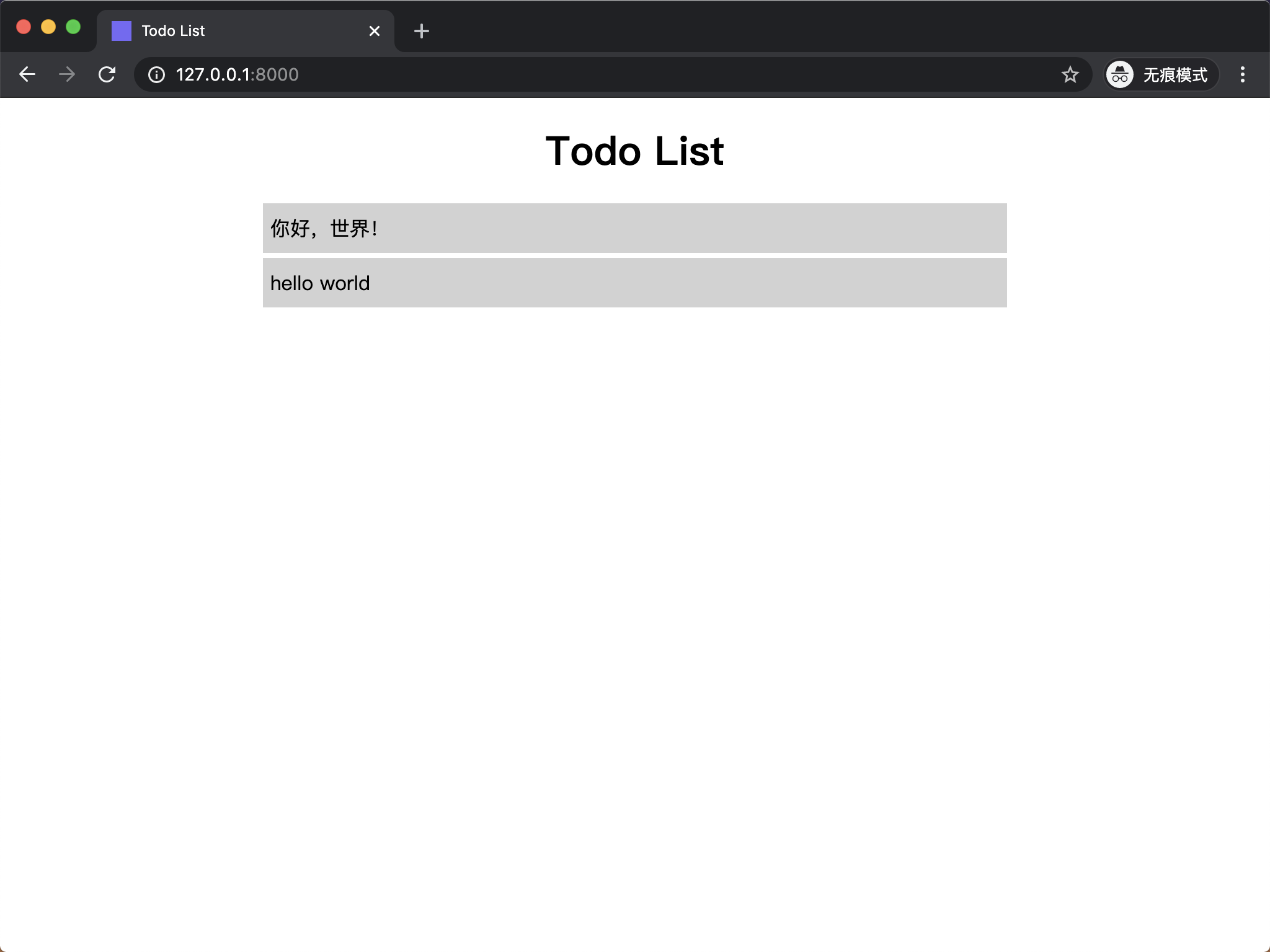处理静态文件 由于我们实现的模板引擎不支持直接将 CSS 嵌入在 HTML 中的写法,所以要将 CSS 独立出来。在 todo/ 目录下新建 static/ 目录,专门用来存储 CSS、JavaScript、图片等静态文件,在 static/ 目录下新建 css/ 目录用来存储 CSS 样式。我们把之前在 todo/templates/index.html HTML 页面中写的 CSS 移动到 todo/static/css/ 目录下的 style.css 文件中:
1 2 3 4 5 6 7 8 9 10 11 12 13 14 15 16 17 18 19 20 21 22 23 24 25 26 27 28 29 30 31 32 33 34 35 36 37 38 39 40 41 * { margin : 0 ; padding : 0 ; } ul { list-style : none; } a { text-decoration : none; outline : none; color : #000000 ; } h1 { margin : 20px auto; } .container { display : flex; justify-content : center; align-items : center; } .container ul { width : 100% ; max-width : 600px ; } .container ul li { height : 40px ; line-height : 40px ; margin-bottom : 4px ; padding : 0 6px ; display : flex; justify-content : space-between; background-color : #d2d2d2 ; }
接下来在首页 HTML 中引入 style.css:
1 2 3 4 5 6 7 8 9 10 11 12 13 14 15 16 17 18 19 20 21 22 23 <!DOCTYPE html > <html > <head > <meta charset ="UTF-8" > <title > Todo List</title > <link rel ="stylesheet" href ="/static/css/style.css" > </head > <body > <h1 class ="container" > Todo List</h1 > <div class ="container" > <ul > {% for todo in todo_list %} <li > <div > {{ todo.content }}</div > </li > {% endfor %} </ul > </div > </body > </html >
浏览器在访问 Todo List 程序首页得到 index.html 源码后,发现 HTML 顶部的 link 标签,浏览器会自动再次发送一个请求到 link 标签 href 属性所指定的网址来获取 CSS 样式。所以我们还要编写一个视图函数来处理 /static/css/style.css 路径的请求,返回 style.css 内容。
1 2 3 4 5 6 7 8 9 10 11 12 13 14 15 16 17 18 19 20 21 22 23 24 25 26 27 28 29 30 31 32 33 34 35 36 37 38 39 40 41 import osfrom todo.config import BASE_DIRfrom todo.utils import Response, render_template... def static (request) : """读取静态资源视图函数""" content_type = { 'css' : 'text/css' , '.js' : 'text/javascript' , 'png' : 'image/png' , 'jpg' : 'image/jpeg' , } headers = { 'Content-Type' : content_type.get(request.path[-3 :], 'text/plain' ), } path = request.path.lstrip('/' ) file_path = os.path.join(BASE_DIR, path) with open(file_path, 'r' ) as f: body = f.read() return Response(body, headers=headers) routes = { ... '/static' : (static, ['GET' ]), }
编写 static 视图函数来专门处理静态文件,它不只能够处理 CSS 类型文件,还支持 JavaScript 文件和图片。实际上静态资源的访问路径被我故意设计为以 /static 开头加上静态文件类型 css 再加上文件名 style.css 的形式,这样只需要编写一个 static 视图函数就能够处理多种类型的静态文件,而不需给 CSS、JavaScript 等静态资源都单独编写一个视图函数。服务器在收到客户端发过来的请求时,判断请求路径以 /static 开头即可断定客户端需要请求静态资源,然后将请求交由 static 视图函数来处理。
假如程序需要用到 JavaScript,只需要在 todo/static/ 目录下新建 js/index.js 文件,当收到请求路径为 /static/js/index.js 的客户端请求时,static 视图函数就能够正确处理响应。
static 视图函数根据不同的资源类型,会指定对应的响应首部字段。浏览器根据响应首部字段 Content-Type 的值来判断响应报文类型,Content-Type: text/html 指明响应报文类型为 HTML,Content-Type: text/css 指明响应报文类型为 CSS。
由于需要指定响应首部字段,所以 static 视图函数返回的并不是响应体,而是直接构造了一个 Response 对象。因此之前编写的 make_response 函数逻辑相应的也需要做些修改:
1 2 3 4 5 6 7 8 9 10 11 12 13 14 15 16 17 18 19 20 21 22 23 24 25 26 27 28 29 30 def make_response (request, headers=None) : """构造响应报文""" status = 200 if request.path.startswith('/static' ): route, methods = routes.get('/static' ) else : route, methods = routes.get(request.path) if request.method not in methods: status = 405 data = 'Method Not Allowed' else : data = route(request) if isinstance(data, Response): response_bytes = bytes(data) else : response = Response(data, headers=headers, status=status) response_bytes = bytes(response) print(f'response_bytes: {response_bytes} ' ) return response_bytes
修改后的 make_response 函数会判断请求路径如果以是 /static 开头则将请求交给 static 视图函数来处理。同时还修改了视图函数的调用接口 data = route(request),每次调用视图函数时需要将 request 对象传递进去,所以记得修改 index 视图函数让其能够接收 request 参数。 make_response 函数最后还对视图函数返回结果 data 做了类型检查,如果返回的是 Response 对象,则可以直接获取响应报文,否则需要先构造 Response 对象,然后再获取响应报文。
终端中进入项目根目录 todo_list/ 下,使用 Python 运行 server.py 文件,就能看到带有 CSS 样式的 Todo List 程序首页了:
Todo List 首页
现在 Todo List 程序已经有了处理静态资源的能力,接下来再给 Todo List 程序添加一个网页图标。
网页图标格式通常为 .ico 文件,将其放到 todo/static/ 目录下。然后在控制器中编写一个 favicon 视图函数用来处理 ICO 图标:
1 2 3 4 5 6 7 8 9 10 11 12 13 14 15 16 17 18 19 20 21 ... def favicon (request) : """读取网页 ICO 图标""" headers = { 'Content-Type' : 'image/x-icon' , } path = f'static/{request.path.lstrip("/" )} ' file_path = os.path.join(BASE_DIR, path) with open(file_path, 'rb' ) as f: body = f.read() return Response(body, headers=headers) routes = { ... '/favicon.ico' : (favicon, ['GET' ]), }
当请求路径为 /favicon.ico 时匹配到 favicon 视图函数进行处理。因为 ICO 图标文件需要以二进制格式来读取,并且不能够直接转换为字符串类型,所以在构造 Response 对象时传入的响应体不再是 str 类型,而是 bytes 类型。因此还要修改下 Response 类,使其能够接收 bytes 类型:
1 2 3 4 5 6 7 8 9 10 11 12 13 14 15 16 17 18 19 20 21 22 23 class Response (object) : """响应类""" ... def __bytes__ (self) : """构造响应报文""" header = f'HTTP/1.1 {self.status} {self.reason_phrase.get(self.status, "" )} \r\n' header += '' .join(f'{k} : {v} \r\n' for k, v in self.headers.items()) blank_line = '\r\n' body = self.body if isinstance(body, str): body = body.encode('utf-8' ) response_message = (header + blank_line).encode('utf-8' ) + body return response_message
只需要修改 Response 类的 __bytes__ 方法即可,根据 body 类型来决定如何构造响应报文。
现在重启 Todo List 程序,浏览器中刷新首页,你会看到浏览器标签页已经显示出 ICO 图标了:
Todo List 图标
本章源码:chapter5

